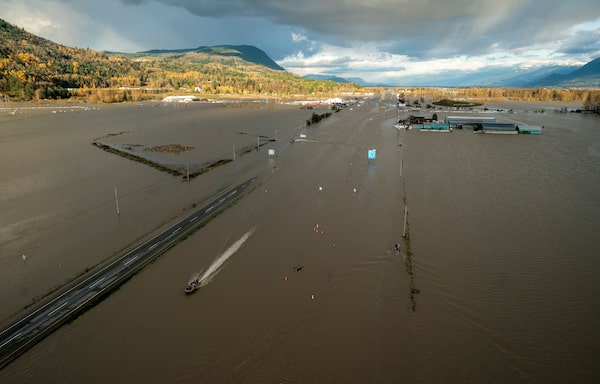
A boat speeds along a flooded highway 1 in Abbotsford, B.C., on Nov. 16, 2021.JONATHAN HAYWARD/The Canadian Press
Glenn McGillivray is managing director of the Institute for Catastrophic Loss Reduction and adjunct professor of disaster and emergency management at York University.
Over the next several days, assessments will be made of the spectacular damage caused by this week’s “atmospheric river” severe rainfall event in British Columbia’s interior.
Starting last Saturday and continuing over the past few days, several watersheds in the region were inundated by well over 200 millimetres of rain – in some cases more than a typical November’s worth. The rain fell over early-season mountain snow, which added to runoff totals.
The steep terrain typical of the area made matters considerably worse, and the cascading effects of the heavy rain were stunning.
Mudslides and debris flows exacerbated by the overactive B.C. wildfire season – and possibly by logging – led to the closures of several key highways. A major washout took out the Coquihalla Highway near Hope, B.C. By Monday afternoon, Vancouver was isolated from the rest of Canada by road.
Cascading effects also included the failure of Merritt, B.C.’s wastewater treatment plant. Along with major flooding, this led to a total evacuation order for the community of 7,000. Residents were warned water is undrinkable, even if boiled.
Power failures were rife, as Hope and other communities lost electricity early in the deluge. By Monday evening, tens of thousands of British Columbians were without power.
What’s more, the region relies heavily on truck deliveries from Vancouver for resupply of the most basic staples. The area’s supply chain was already disrupted this week, as pictures of bare shelves in grocery stores were posted on social media.
A wise person in my field once said, “All disasters are cascading.” Ain’t that the truth.
It is generally understood in disaster research that most severe loss events are local. But this one is much larger.
This is partly why this situation is unique. Often during a flood event, one community is impacted, making it easier for authorities to direct resources toward that one area. With this event, however, the list of communities hit is long: Merritt, Hope, Mission, Golden, Chilliwack, Abbotsford, Princeton and others.
Just weeks ago, B.C. was faced with the uncharacteristic challenge of having to deal with multiple, simultaneous fire events at the wildland-urban interface. Now, it uncharacteristically has to deal with multiple flooding events at once.
It’s challenging enough to deal with one event in one place at one time. But these are exactly the kinds of greater challenges a warmer climate that is sometimes drier, sometimes wetter, will bring.
Incredibly, just about 130 days after obliterating heat records by close to 5 C (almost unheard of, as new records usually outpace old by just tenths of a degree), large portions of the same areas are now underwater.
Climate change, it appears, is becoming a consumer of small Canadian communities.
On June 30, just one day after Lytton, B.C., exceeded the heat record for the area, the community was lost to a climate-change-fuelled wildfire. Incredibly, 90 per cent of the village was razed in just 20 minutes, killing two residents. Large portions of Monte Lake, B.C., and other small communities were also lost by wildfire this summer.
According to a recent report, the June heat wave led to the deaths of almost 600 British Columbians, most over the age of 70. This number is roughly six times larger than the population of Lytton, and is comparable to a small community by itself.
Climate change is like a heat-seeking missile. But instead of being attracted to the heat signature of an enemy’s aircraft, it seeks out marginalized people and communities.
And small Canadian communities are at prime risk.
At a news conference earlier this week, defending the province’s disaster response, the minister responsible noted that emergencies such as flooding and mudslides start at the local level.
The problem is that small communities don’t have resources that larger ones have. They don’t have an adequate first response, nor do they have the resources to identify vulnerabilities and properly address them before disaster strikes (as outlined in this ominous piece of just a week ago).
The way we manage disasters in Canada is just another anachronistic shortcoming created in and for another time, and this must change.
What we are seeing in places like B.C. these days is not “normal.” It’s just another way station on the washed out road to the Anthropocene.
Keep your Opinions sharp and informed. Get the Opinion newsletter. Sign up today.